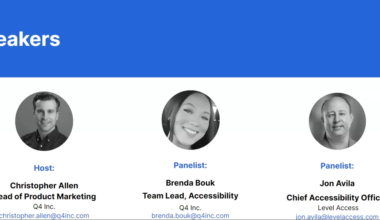To embrace inclusivity and captivate a diverse audience, you must prioritize accessibility and compliance in your IR communications. In today’s digital environment, it’s important to remember that not everyone uses the internet the same way, even in the market. Digital accessibility standards in 2023 are pivotal in ensuring equal access and inclusivity for all, regardless of their individual needs and abilities.
In continuation of Q4’s series of webinars with our partners at Level Access and in recognition of the 12 annual Global Accessibility Awareness Day, we hosted a webinar, Accessibility in 2023 & Beyond: What an IRO Needs to Know, to address accessibility standards and its implications in the IR industry. This webinar featured an impressive panel, including Steve Esterly and Brayden McCullagh, Q4 Inc., and Jonathan Avila, Level Access.
What are Digital Accessibility Standards?
Digital accessibility standards involve designing technology to be inclusive and functional for people with disabilities. Rather than demanding a complete overhaul of existing digital programs, the focus is on integrating accessibility features into the code of websites, apps, and other platforms. Avila emphasizes that understanding digital accessibility requires considering three key topics: disability, barriers, and user needs. By addressing these categories, organizations can create digital experiences that are inclusive and accommodating for all users.
Disability
Esterly highlights that disability encompasses various conditions such as visual impairment, hearing impairment, cognitive and neurodiverse disabilities, and invisible disabilities. Additionally, there is a significant intersectionality among disabilities, with aging often resulting in the experience of multiple disabilities. Approximately 1 in 6 people worldwide and 1 in 4 in the United States have disabilities. Understanding and addressing the diverse range of disabilities is paramount when prioritizing accessibility.
Barriers
Common barriers in website and mobile app design include low-contrast text, images lacking alternative text, unclear link taxonomy, and color-related issues in charts. These barriers impact many users, including those with color blindness, visual impairments, and hearing impairments. Overcoming these barriers and addressing user needs should be integral considerations during the design phase.
User needs
When designing your website with user needs in mind, it is essential to address the following questions:
- What are the specific needs and challenges of your users?
- What issues arise when examining inaccessible websites?
- What aspects are currently practical for different disabilities? For instance, consider scenarios like filling out an investor engagement form where users with specific disabilities might rely on auditory cues and need clear guidance on data input fields.
How Does Digital Accessibility in 2023 Affect IR?
Digital accessibility standards have a dual impact on investor relations (IR): compliance and inclusive outreach. According to McCullagh, the rise of digital accessibility lawsuits at a 12% yearly increase since 2002 highlights the importance of complying with regulations to safeguard your business and investors. Simultaneously, ensuring accessibility becomes a competitive advantage, enabling your message to reach a broader investor audience while mitigating the risk of exclusion. Notably, a recent study revealed that individuals with disabilities possess a substantial $13 trillion in disposable income. Failing to prioritize accessibility means potentially missing out on this significant market opportunity.
Accessibility and ESG
With investors increasingly paying attention to social impact, an effective accessibility strategy holds significant sway in bolstering your ESG narrative. According to McCullagh, recent studies have shed light on the impact of ESG initiatives on different generations, particularly the younger cohort. Notably, a survey conducted by RBC revealed that an impressive 75% of younger individuals prioritize ESG factors when making investment decisions, whereas a mere 37% of older generations share the same sentiment. These findings underscore the growing significance of ESG considerations necessary for IR, especially since companies that include ESG initiatives tend to outperform their non-ESG alternatives.
Accessibility is an integral part of ESG – the social aspect, particularly – as the two are intertwined. A solid commitment to ESG necessitates a focus on accessibility, reflected in organizations that actively pursue diversity, equality, inclusion and accessibility (DEA) efforts, which are often interconnected. Consequently, considering accessibility goes beyond the external aspects of website design. It also extends to internal practices such as hiring, retention, and technology procurement from third parties or self-development. By embracing accessibility as a fundamental value, organizations strengthen their ESG commitment and contribute to a more equitable and inclusive society.
Upholding Digital Accessibility Standards
To ensure your IR website is accessible, the panel suggests referring to the four Web Content Accessibility Guidelines (WCAG) principles, using the acronym POUR (Perceivable, Operable, Understandable, and Robust):
Perceivable:
Ensuring information and user interface components are present in a way that can be perceived. If they can’t be perceived, they do not exist.
Operable:
Making sure that the site is available via any method necessary.
Understandable:
Ensuring anyone who accesses your material can understand it. It must be clear, predictable, and interactive. And it must provide us with sufficient information that you will take proper action.
Robust:
Ensuring that the content is created in a way that communicates with all technologies. So whether or not you’re viewing the site on the screen reader, a laptop or mobile device, accessibility components spread across all those devices.
Key Themes Moving Forward
An essential resource to rely on is the set of international voluntary consensus standards known as the Web Content Accessibility Guidelines (WCAG), created by the World Wide Web Consortium (W3C). These are vital resources for global accessibility practices. Governments have adopted these standards, making them crucial for assessing digital content like web pages, mobile apps, and non-web documents (e.g., PDFs, PowerPoint presentations).
While web standards provide a minimum level of accessibility, conducting user testing with individuals with disabilities is also recommended to understand their needs better and optimize digital platforms. Involving people with disabilities in the design and testing process fosters a user-centered and inclusive approach to accessibility.
Joe encourages IR professionals to implement accessibility at the earliest stages and offers the following advice moving forward:
- Implement role-based training for designers, developers, and project managers.
- Provide appropriate templates and tools for different content creation abilities.
- Conduct automated tests to identify and address accessibility issues before publishing content.
- Adopt a holistic approach, considering all materials beyond just the website (e.g., emails, surveys, third-party cookies).
- Stay up to date on regulations, such as the Americans with Disabilities Act, to maintain ongoing accessibility compliance.
- Seek third-party validation to ensure the correct implementation of accessibility measures.
- Embrace feedback and iterate continuously, treating accessibility as a continuous and agile process.
For more information, reach out to our team of experts. Alongside our partners at Level Access, we can ensure your IR website is compliant and accessible.


